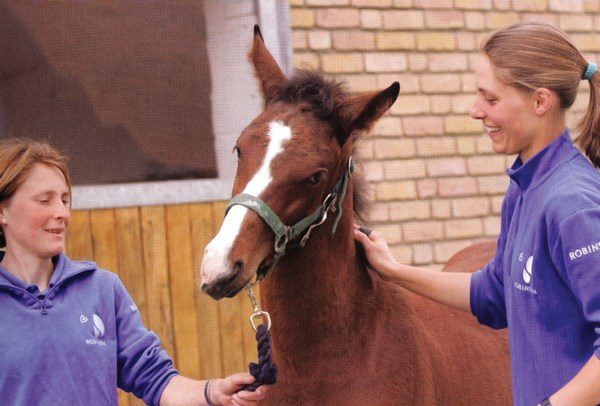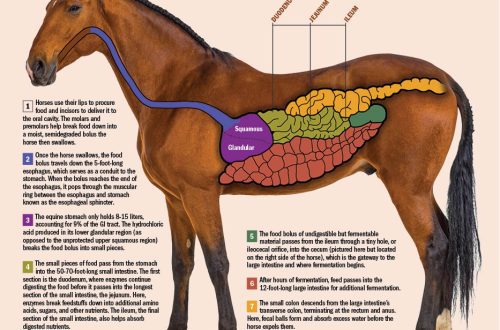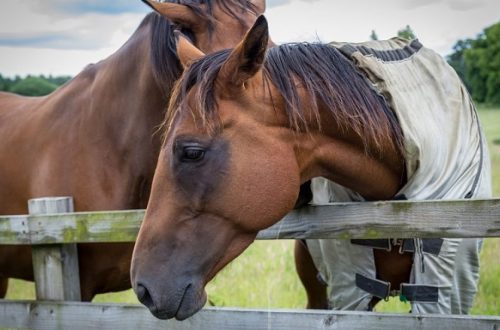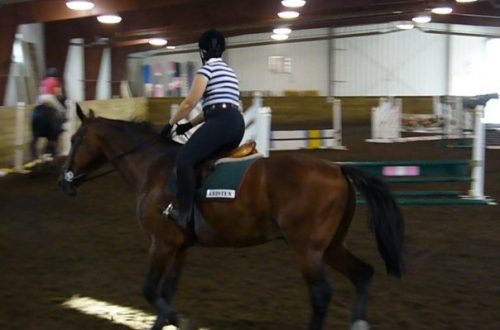
Ingrid Klimke on getting started with foals
Ingrid Klimke on getting started with foals
In the past, trainers often took horses into training from foal age. While the foal was growing and developing, he was taught the basic rules, which subsequently greatly facilitated the beginning of work under the saddle. Nowadays, most people prefer to buy three- and four-year-old horses that have already been worn out. At the same time, the buyer often has no idea what happened to this horse before the purchase, how it worked at a young age before the race. By caring for a young horse, you will learn not only how to feed and care for him, but also how to approach his training in the future.
A three-year-old horse raised among people trusts his environment. Therefore, she will be easier to train when she gets older – she will be more social than a horse raised “in the field.” However, despite this initial “advantage”, experience shows that horses that have spent more time “in the wild” learn just as well in the long run as those raised “in the family”. The Wild Ones are afraid at first and need more attention, but once they get used to trusting people, they become very reliable.
It is extremely difficult to gain the trust of a young horse that has been mistreated or mistreated before you. They are definitely not easy during basic training – you will have to gradually and carefully figure out what problems they have in order to overcome them. Keep in mind, however, that if you are too gentle with your horse to gain his trust, you also run the risk of getting into trouble. Of course, the method of handling a horse is a personal matter for each rider, but one should not try to humanize a horse.
Training starts at foal age
A good breeder builds the foundation of trust by raising and interacting with young horses the right way. And this prepares them for the subsequent work under the rider.
Training begins at foal age. The first days and weeks set the stage for the further development of a trusting working partnership between man and horse. And here it is not the hours of aimless play with the foal that are important, but the gaining of his trust. It begins with accustoming foals to life in the stable. Foals are naturally inquisitive and after a while will try to make contact with a person. This process can be accelerated by adding courage to the foal. Squat down to be the same height as him and wait until the foal approaches you. Contact will develop. First you need to stay with a foal of the same “height” and pet him. Then try to hold the foal in place (put your left hand under his neck, and wrap your right around the croup). So the foal learns that freedom can be limited. His innate desire for freedom must slowly but surely be controlled.
As soon as the foal starts to let you hold him for a short time, you can introduce him to a halter (it should not be too big) that is fastened around the neck. The advantage is that in this way you do not have to touch the sensitive area of the ears. Wearing a halter, praise the foal. This is enough for the first lesson. When the foal is comfortable with the halter, you can try to lead him.
To begin with, try to just walk with the foal – let him go by himself, do not pull him. This can also be done in the stable. The next step is to bring the mare from the stable to the nearest levada by the rope. The foal must be in a halter. The first outing can be confusing for a young mare, so you may need help. These short walks should be fun for the foal, as well as build his self-confidence.
Therefore, it is especially important to be careful during these first days when you drive it. Don’t pull him by the lead. If the foal stops, the person leading the mare must walk forward without stopping. The farther the mare goes from the foal, the more incentive he has to follow her. The person who leads the foal should not turn around and look at him. He must stop and wait for the foal to follow the mother.
As soon as the foal’s trust is won and he goes, the baby will need to be praised immediately. A short word will suffice. Excessive petting and caressing at this age is dangerous because it makes the foal want to play, and this may encourage him to start biting you, which is undesirable.
Foals are inquisitive. They want to feel and taste everything – the halter, the lead, and sometimes the mane and tail of the mother. Even your hand will be interesting to him. If you let your foal play with you, you will most likely find yourself with a few bruises. You must distinguish between an inquisitive nibble and a vicious or dominant bite. Often bad behavior and the formation of bad habits are exacerbated by the coach himself. Experienced breeders do not allow foals to close contact. They keep them at a safe distance and do training exercises for a few minutes at a time.
When the foal allows you to follow the mother, you can begin the next step – try to tie him. It used to be done on the street. They used a strong rope or chain that would not break if the foal pulled on it. Later studies by veterinarians have shown that the inability to coordinate muscle movement may be due to strong pressure on the upper vertebrae of the neck. So this method has been changed.
First, they try to tie the foal in the stable. The cord goes through a ring in the wall and the end is held loosely in your hand, allowing you to soften and dial it in as needed. Tie the foal to the mother’s girth and go out for a short walk is another way to easily introduce the foal to the leash. The foal must learn to stand next to the handler when he is standing.
Next we will try to take the foal’s legs and clean it.
Foals like to be brushed with either a rubber comb or a soft brush.
In gratitude, they begin to try to bite the person in response. However, if the foal bites you, it is best to push it away or say “no!” sharply and loudly. This behavior with people is undesirable and should be corrected before the foal grows up.
A foal can be easily taught to raise its legs. You need to start with the leg that is least loaded. We lift it not too high, so that the foal does not lose balance. It doesn’t matter if you lifted the front or back leg first, you need to say “leg” when you do so that the foal learns to understand what is being asked of him.
If the foal can be led on a lead, he gives his legs and allows himself to be cleaned, then this is already good. At this stage, nothing more is required. Training a horse is a long and difficult process, no need to complicate it. In the first and second years of life, the young horse should be given the opportunity to grow naturally by spending a lot of time in the paddock or in the field.
Demonstration of a horse in hand
Stud farms in Germany prepare young stallions for breeding, which is carried out when they are 3 years old. Mares are also judged at this age. Data about them is entered in the stud book of the corresponding breed. Ideally, the goal is to showcase the horse in hand at the annual Elite Show. To get there, horses must be carefully trained. If they make a good impression, it will increase their value. In addition to the big shows, there are other situations where a young horse will need to demonstrate their movement and conformation. In addition to the show in the hands (to demonstrate the movement), a handstand is provided (the horse is examined during the stop). Traditionally, the display in the hands is carried out on a snaffle bridle.
Brooding can be seen as a simple addition to training a horse that has yet to get into work. Preparation for it can be useful for two-year-olds as an additional exercise preceding a further race.
Inspection of a horse standing still
Working in the hands trains the horse and at the same time brings him pleasure.
To present a horse for examination, stop it (always on level ground) so that its shoulders are level with the judge, step forward and stand in front of the horse, legs slightly apart. We hold the right rein in the left hand, and the right hand holds the left rein at a distance of a fist from the snaffle rings. The thumbs should be on the rein, the end of the rein twisted and held with the right hand. The horse should stand on four legs, “square”. If the horse does not immediately stand up correctly, it can be corrected by either gently pushing forward or backward. From this position, the horse should be allowed to take half a step forward so that it becomes “square”, with its legs slightly apart so that the judge can clearly see them (as in the photo above). The horse’s head and neck should be slightly forward (not too much) so that the forehand can be judged. The back should not sag.
After the demonstration, we go back and stand on the left side of the horse (rein in the right hand). The rein should pass between the index and middle fingers, the hand should be at a distance of a fist from the rings of the snaffle. The outside (right) rein should be shorter than the inside (left) so that the horse cannot turn his head inward. In this way, we help the horse to move straight when he trots. The ends of the reins pass from top to bottom in the right hand and are held in place with the thumb.
Ways of conducting in hands
There are two ways to lead a horse in the show. In Germany, horses are usually judged in a closed show ring (most often triangular). As a rule, the horse is led up and down the arena in straight lines and at the end of each horse turns to the right, bypassing the lead person. First, the horse is shown at a walk, and then at a trot.
Accompany the horse on the left side, being level with the horse’s head. The right hand (in which the rein) is at shoulder height; the left hand hangs down. When showing a horse at a trot, you need to run in time with the steps of the horse. If the horse is moving too fast, he can be calmed down by gently raising his left hand. A horse often breaks into a canter if it is trotted without contact with the reins. It is best to maintain a light contact that does not interfere with the rhythm of the trot.
The output is very important. A young horse needs to be introduced to every single aspect of it. We recommend using a long dressage whip during training. Start by standing close to his left shoulder and keeping the reins long enough for the horse to respond to light contact. Then lead the horse on a long rein, as it was led by a foal on a lead lead. This procedure is familiar to her and will not cause stress. It is important to stay near the horse’s head and neck, and not stand in front of him. You must also walk confidently and clearly so that the horse knows exactly what to do and does not get distracted. As soon as she does, stop and calmly say “stop”. A young horse may take a step before stopping, but he must pay attention. Then tighten the reins slightly and loosen them immediately to avoid possible resistance from the horse. At this point, briefly pat her neck and wait a little while looking at her. Then look ahead again and say “forward.” Move on. The horse should follow you, but if he hesitates, lightly touch his bottom with the whip.
We repeat this walk/stop exercise until the horse understands it and performs well. It usually only takes a few days. We always allow the horse to run freely and get rid of excess energy in advance. Subsequently, the exercise is performed by her without any problems, the horse is calm and relaxed. But be prepared – the day will come when the horse will become tense and shy. This usually happens when she is introduced to the work of the trot. This is a test of your reactions – you always need to be faster than the horse. Sometimes the only way to maintain control is to make more persistent rein contact. It should be very clear to the horse that he must stop and not go any further. But you must not pull the horse back by the mouth or rein him in. At a later stage, when the horse is more obedient, he can be led with his left hand in front of his muzzle and he will maintain a calm trot or walk rhythm.
Successful horse management depends on the degree of control in your hand.
If you are leading a lazy horse, it will be better if you have an assistant to help you. He needs to go behind and encourage the horse with the whip (without scaring him or using physical force).
Obedience in the hands is an important factor in preparing a riding horse for basic training. Young horses that trust people and are confident in themselves are ready to learn new things.
Ingrid Klimke (source); translation Valeria Smirnova.





